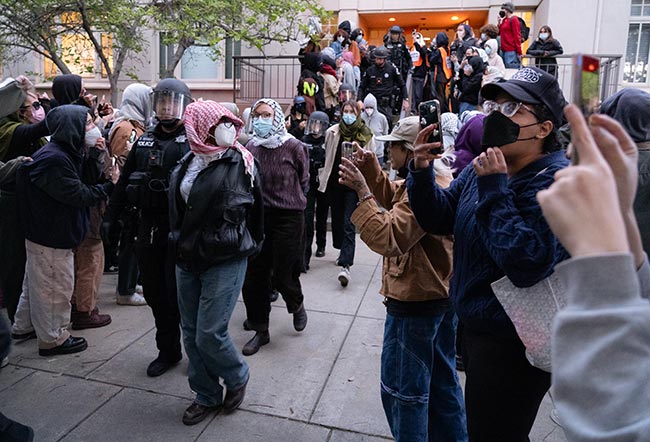Claremont school district reacts to new cyber bullying law
California schools will be enforcing rules on cyber bullying in 2014. The passage of Assembly bill 256 into law includes cases of off-campus cyber bullying as a reason for suspension or expulsion.
The law was approved by Governor Jerry Brown on October 10, 2013 and took effect as the clock struck midnight on New Years. According to law, cyber bullying is defined as using computers, smart phones and social media to harass or threaten a person. This can include spreading rumors or creating “burn pages” that target a specific individual.
Assemblymember Cristina Garcia (58th district) proposed the bill last February after she had her own experience with cyber bullying that left her hands tied.
“I feel very strongly that every young person should be able to thrive in our schools, without the added stress of being bullied,” Ms. Garcia said in a statement released when the bill was signed.
Ms. Garcia was teaching a math class as part of an after school enrichment program. It was the end of the year and she was planning a celebration for her students. During the class she witnessed five boys taunting another classmate and did her best to break-up their bullying. After she intervened she found out that the taunting had been going on for the entire year via off-campus and online bullying. She was unable to take measures to remedy the situation because none of it happened on-campus. This incident is what inspired her to take action.
“AB 256 closes a large loophole in anti-bullying law to match the reality we live in today by updating laws written before the explosive growth of electronic devices and instant communication,” Ms. Garcia wrote. “By supporting this bill, the Governor and the Legislature have made a clear statement that student bullying is unacceptable and that it will not be tolerated in any way, shape or form.”
While 48 states have laws that deal with bullying, only 38 have laws that address cyber bullying. Then only a small percentage treats these cases of bullying separately from the broader topic of “bullying” in schools, according to iSAFE statistics. In many cases of cyber bullying the administration is left with little room to discipline since the encounters do not happen in plain sight.
Previously, in order for the school to discipline students who engage in bullying, it would have had to have taken place while the students were traveling to and from school, on campus during school hours or as part of a school-sponsored event. Cyber bullying was included in this discipline, but the original statement outlined what falls under the definition of cyber bullying rather than situations that could be handled by schools.
As the bill was being proposed by Ms. Garcia, the Claremont Unified School District was taking measures of their own to ensure the safety of their students both on and off-campus. In a June 2013 school board meeting, the board voted on the wording of CUSD’s own bullying policy to include instances of off-campus cyber bullying. Rather than allowing situations to go unattended, any instance of bullying that is a substantial interruption to school activities is dealt with by the administration.
CUSD looks at each case individually to ensure that each student’s situation is considered from every angle. Now that the law has taken effect, the district has the backup of the state to protect the students.
“None of our schools condone bullying on or off-campus and a lot of times it is reported to us before it becomes a bigger issue,” said Mike Bateman, assistant superintendent of student services. “If we can’t do it on a school basis, we do invite the law enforcement to take a look at the situation.”
Last year, while the CUSD did have a few disciplinary cases to take care of, none of them were related to cyber bullying. Teachers and administrators are often times able to catch the situation before it becomes worse and offer mediation before students turn to social media.
“Some kids are afraid and don’t want to be the tattle or the snitch. My approach to the situation is to ask the kids if there is anyone else around that saw what happened or knows about what happened,” Assistant Principal of El Roble Intermediate School, Clarissa McNally said. “It takes pressure off of the student so they will be more open to share what is going on.”
Ms. McNally has handled minor situations of bullying in the past at El Roble and has steps in place to ensure that each unique case is handled appropriately.
In situations where a student is being bullied via social media, students will reach out to a faculty member and be directed to Ms. McNally. They are then able to show her what is happening so she can evaluate the situation. From there, she can meet with parents or, if the circumstances have caused a disruption at the school, direct the case to the district.
Along with sit-down interactions the district has proactive programs in place through the students time in school to remind them of what is important when interacting with peers. Through programs like the junior high after-school program TRACKS, speakers and workshops have been held to ensure students are able to identify what bullying looks like and report it. On-campus access includes counselors who are available to talk to students at anytime and counselors from the University of La Verne who come in to talk to students on a regular basis.
At Claremont High School AVID coordinator Erin Fowler took notice of cyber bullying that was going on in her senior AVID class and decided to address the problem with class discussions. She gathered articles from all around the world and shared them with the class. They then tried to break down the situations to find out if blame could be placed and how to handle the situations appropriately.
From the discussion her students sprang into action and created an anti-bullying documentary based on school-wide statistics, student testimonies and reactions from around campus. This documentary was shown in the freshmen classes for the first six weeks of school to acknowledge that CHS is anti-bullying.
Now that the documentary is completed the students want to take it school-wide this spring and show it in a class rather than use the wolf cast that is played as part of morning bulletins, said Ms. Fowler. The students hope that by showing it in the class their peers will start a discussion and be more willing to address issues they might be having.
Last year, the Claremont High School AVID classes participated in anti-bullying week in October with posters, T-shirts and teal support bracelets that each student handed out to spread awareness. Other schools programs, like the elementary “Character Counts” program, emphasize six traits to live by: trustworthiness, respect, responsibility, fairness, caring and citizenship. From the point when students start school to when they finish, they are reminded that bullying will not be tolerated.
“The policy had always existed via the Internet and face-to-face conflict, and if the situation caused a disruption then it was addressed,” Mr. Bateman said. “This policy allows us to do what we already addressed so we have the ability to suspend and expel students.”
—Christina Burton
storribio@claremont-courier.com








0 Comments